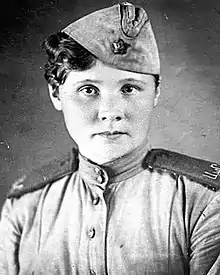Tatyana Baramzina
Tatyana Nikolayevna Baramzina (Russian: Татья́на Никола́евна Барамзина́; 19 December 1919 – 5 July 1944) was a Soviet sniper in the Great Patriotic War credited with a minimum of 36 kills. After being wounded in battle she was captured, tortured, and executed by German soldiers in Smalyavichy. She was posthumously awarded the title of the Hero of the Soviet Union on 24 March 1945.[1]
Tatyana Nikolayevna Baramzina | |
|---|---|
 | |
| Native name | Татьяна Николаевна Барамзина |
| Born | 19 December 1919 Glazov, Russian SFSR |
| Died | 5 July 1944 (aged 24) Smalyavichy, Byelorussian SSR, Soviet Union |
| Allegiance | |
| Service/ | Red Army |
| Years of service | 1943–1944 |
| Rank | Corporal |
| Unit | 252nd Rifle Regiment |
| Battles/wars | Great Patriotic War † |
| Awards | Hero of the Soviet Union |
Early life
Born in the city of Glazov in the Udmurt ASSR, she was the fifth of six children born to a working family. After graduating from secondary school in 1934 Baramzina graduated from the Glazov State Pedagogical Institute and spent two years teaching a kindergarten class in a village school at Kachkashur. On 2 November 1937 she applied to join the Komsomol and was accepted one month later. In 1940, she enrolled at University in Perm, and when Germany invaded the Soviet Union, she began to attend nursing courses in the evening, while training to become a sharpshooter.[2][3]
World War II
In June 1943 she was sent to the Central Women’s Sniper Training School outside Moscow and, upon graduation in April 1944, she was sent to the 3rd Belorussian Front. Within her first three months, she had killed at least 16 enemy soldiers, while serving in the 3rd Battalion of the 252nd Rifle Regiment (70th Rifle Division, 33rd Army).[2]
In the beginning of the war she served as a sniper but due to suffering problems with her vision she was retrained to work as a telephone operator; she repaired fourteen telephone connection lines under heavy artillery fire in the battle of Maloye Morozovo in June 1944.[4]
On July 5, 1944 Baramzina's battalion parachuted behind enemy lines as part of a larger attempt to seize the crossroads near the village of Pekalin in Smalyavichy, hoping to block the retreat of German forces. An engagement broke out before they reached the crossroads, and the battalion took heavy casualties due to being heavily outnumbered.[5] After killing 20 German soldiers, Baramzina was reassigned to care for the wounded personnel due to her medical training.[2]
The trench that was being used to hold the Soviet wounded was re-taken by German forces, and Baramzina evacuated as many injured Soviet soldiers as she could to the forest before the trenches were taken over. German soldiers raided the dugouts holding injured soldiers, shooting the wounded with high-powered anti-tank rifles (Panzerbüchse). After being wounded by artillery fire in the chaos, she was captured and subjected to torture in an attempt to have her divulge information on the number of troops and what regiment she was from. After her eyes had been gouged out, Baramzina was subsequently shot point-blank with an anti-tank rifle. Her body was mutilated to the point that only pieces of her hair and uniform could be used for identification, and what remained of her was buried in the Volma mass grave in until the remains were transferred in 1963 to Kalita.[6][7]
Commemoration
In addition to a monument in the local Glazov park, Proletarskaya Street, on which she had grown up, was renamed in her honour, as well as streets in Minsk and Izhevsk and outside the Central Women's Sniper Training School.[8] The Young Pioneers group at the school in which she had been teaching was also renamed in her memory. A diorama depicting her last stand was placed in the Belarusian Great Patriotic War Museum but it was relocated to the Military Academy of Belarus in 2014.[9]
References
- Sakaida, Henry (20 April 2012). Heroines of the Soviet Union 1941–45. Bloomsbury Publishing. p. 56. ISBN 9781780966922.
- Simonov, Andrey. "Барамзина Татьяна Николаевна". warheroes.ru. Retrieved 23 December 2017.
- "Неизвестные страницы жизни Героя Советского Союза Т.Н. Барамзиной". gasur.ru. Retrieved 31 January 2018.
- Cottam 1998, p. 169-170.
- Cottam 1998, p. 170.
- Владимир. "Татьяна Барамзина сражалась в тылу врага, была связистом и снайпером". www.iz-article.ru. Retrieved 31 January 2018.
- "Таня с улицы Пролетарской". kr-znamya.ru (in Russian). Retrieved 23 December 2017.
- Подольчане Герои Советского Союза Archived 2007-09-28 at the Wayback Machine
- "Глазовский краеведческий музей". Глазовский краеведческий музей (in Russian). Retrieved 23 April 2018.
Bibliography
- Simonov, Andrey; Chudinova, Svetlana (2017). Женщины - Герои Советского Союза и России. Moscow: Russian Knights Foundation and Museum of Technology Vadim Zadorozhny. ISBN 9785990960701. OCLC 1019634607.
- Cottam, Kazimiera (1998). Women in War and Resistance: Selected Biographies of Soviet Women Soldiers. Newburyport, MA: Focus Publishing/R. Pullins Co. ISBN 1585101605. OCLC 228063546.